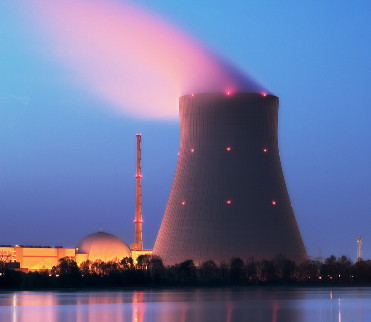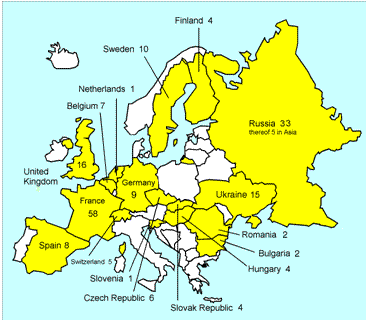Stress tests of nuclear power plants in EU released new concerns

European activists are joining their voices and worries after European Commision released this week their “stress tests” report of nuclear power plants (NPP) in Europe. By the report there are currently 145 nuclear reactors in 15 European states, EC states that safety record is such that although incidents have occurred and continue to occur, no major accidents have ever taken place. Activists said the report dodges the real issues.
The results don’t say that any nuclear reactor in Europe is too unsafe to operate. But they identify concerns across Europe, including a lack of seismic measuring instruments, insufficient safety and rescue equipment, and inadequate emergency plans. The largest number of concerns was found in France, the leader in number of nuclear reactors in EU.
Anti-nuclear campaigners criticised the report, which they said glosses over more serious concerns. “The final report of the EU nuclear stress tests charade looks set to dodge all the tough questions, as expected,” said German Green MEP Rebecca Harms (europeanvoice.com).
In introduction to released “stress tests” EC states that the challenges which nuclear safety and its governance face were highlighted in the accident at the Fukushima reactors in Japan following the earthquake and the tsunami in March 2011. This event demonstrated that nuclear reactors must be protected even against accidents which have been assessed as highly improbable. Events at Fukushima revealed well-known and recurring issues: faulty design, insufficient backup systems, human error, inadequate contingency plans, and poor communications. The EU must learn the lessons of Fukushima to further reduce the risk of nuclear incidents in Europe.
The Fukushima accident resulted in unprecedented efforts to review the safety of nuclear installations in Europe and worldwide. Initiatives were taken at national, regional and international level. In the EU, the European Council, in March 2011 concluded that “the safety of all EU nuclear plants should be reviewed, on the basis of a comprehensive and transparent risk and safety assessment (“stress tests”).
The European Nuclear Safety Regulatory Group (ENSREG) and the Commission were invited in March 2011 to develop the scope and modalities of these tests in a coordinated framework. The “stress tests” results were published on Thursday, October 4, 2012. You can find them here. Full reports, Union wide, can be found in a document here.
In addition to recommending numerous of plant specific technical improvements, the stress tests have shown that International standards and practices have not been applied everywhere. In addition, lessons from Fukushima need to be drawn. In particular, these include:
- Earthquake risk: In the design of 54 EU reactor units out of 145 (37%), modern standards for earthquake risk calculation are not taken into account. The risk calculation should be based on a 10 000 year time frame, instead of the much shorter time frames sometimes used.
- Flooding risk: In the design of 62 reactors (43%), modern standards for flooding risk calculation are not taken into account. The risk calculation should be based on a 10 000 year time frame, instead of the much shorter time frames sometimes used.
- Minimum seismic hazard level: The internationally recommended minimum seismic hazard level, regardless of any lower apparent exposure to seismic hazard, has not been used for the seismic hazard studies of 65 reactors (45%).
- Equipment to fight severe accidents should be stored in places protected even in the event of general devastation and from where it can be quickly retrieved. This is not the case for 81 reactors (56%).
- On-site seismic instruments to measure and alert of possible earthquakes should be available at every nuclear power plant. These instruments should be installed or improved in 121 reactors (83%).
- After a Station Blackout, the NPP should be able to cope for more than 1 hour without intervention before safety functions need to be restored, in order to prevent reactor core heat-up. This is not the case in 5 reactors (3%).
- Emergency Operating Procedures should cover all NPP states (i.e. full power to shutdown states). This is not the case in 57 reactors (39%).
- Severe Accident Management Guidelines should be implemented and cover all plant states (i.e. full power to shutdown states). This is not the case in 79 reactors (54%).
- Passive measures (i.e. measures which do not require initiation by any other system or human intervention) to prevent hydrogen explosions (or of other combustible gases) in case of severe accident should be in place. This is not the case in 40 reactors (28%).
- Containment filtered venting systems to allow safe depressurizing of the reactor containment in case of an accident should be in place. 32 reactors do not have these systems yet (22%).
- Backup emergency control room should be available in case the main control room becomes inhabitable as a consequence of the radiological releases from a severe accident, of fire in the main control room or due to damage from extreme external hazards. These are not available for 24 reactors (17%).
Nuclear stress tests – flaws, blind spots and complacency
In an article published on Greenpeace website Greenpeace stated that they hired independent consultants to analyse the results of ‘stress tests’ carried out on nuclear plants in Europe. They came to some alarming conclusions, summarised in briefing Nuclear Stress Tests – flaws, blind spots and complacency.
Independent analysis of the stress test results revealed the following headline threats:
- Alarming shortfalls in back-up power for nuclear plants, including multiple reactors relying on single emergency diesel generators in case of disaster. Some plants were found to be incapable of handling challenging earthquake or flood conditions. Radiation shielding was woefully inadequate in dangerous spent fuel storage across the continent.
- Testers have ignored multiple disaster scenarios, like that at Fukushima. Most also ignored plane crashes and all ignored emergency evacuation plans, despite the fact plants are as close as 10 kilometres to European cities.
- There is little consistency in the findings, making comparison between plants difficult or impossible.
The research focuses on example nuclear plants in Belgium, Sweden, France, the UK, Czech Republic, Slovakia, Germany, Slovenia and Spain. The research is complemented by independent calculations (maps) showing how nuclear clouds could spread across Europe following a severe nuclear accident.
For a copy of the full consultancy report, click here.
Greenpeace report slams Swedish nuclear plants
According to a new report from environment organization Greenpeace security risks at Sweden’s nuclear power plants are so high that the facilities should all be taken out of operation.
“We are killing off the myth that Swedish nuclear power is safe. Swedish power plants are old, have great security risks, there is a lack of both personnel and skills and a large number of incidents are occurring,” said Rolf Lindahl, who has worked on the report, to daily Svenska Dagbladet (SvD). “With old reactors one should put all efforts into guaranteeing safety, but it would seem as if the primary goal is the financial gains and that they are taking chances when it comes to security,” said Lindahl to SvD.
Power plant Ringhals has previously been slammed for not having enough protection against earthquakes and floods. The new report reveals that Sweden’s other two wouldn’t be able to withstand natural disasters. Forsmark, north of Uppsala on the eastern coast, could only take a rise in water levels of 2.5 metres before its diesel generators would be put out of commission. Oskarshamn, in southern Sweden, would be in serious trouble in a situation where electricity and the ability to control the temperature is wiped out. The protection against terrorist attacks is also bad, concludes the report (www.thelocal.se).
Nuclear power plants in Europe
Nuclear power plants in Europe, in operation and under construction, as of July 2012 according to European Nuclear Society.
|
Country |
in operation |
under construction |
||
|
number |
net capacity MWe |
number |
net capacity MWe
|
|
| Belgium |
7
|
5,927
|
–
|
–
|
| Bulgaria |
2
|
1,906
|
– |
– |
| Czech Repuplic |
6
|
3,766
|
–
|
–
|
| Finland |
4
|
2,736
|
1 |
1,600 |
| France |
58
|
63,130
|
1 |
1,600 |
| Germany |
9
|
12,068
|
–
|
–
|
| Hungary |
4
|
1,889
|
–
|
–
|
| Netherlands |
1
|
482
|
–
|
–
|
| Romania |
2
|
1,300
|
–
|
–
|
| Russian Federation |
33
|
23,643
|
10
|
8,203
|
| Slovakian Republic |
4
|
1,816
|
2 |
782 |
| Slovenia |
1
|
688
|
–
|
–
|
| Spain |
8
|
7,567
|
–
|
–
|
| Sweden |
10
|
9,325
|
–
|
–
|
| Switzerland |
5
|
3,263
|
–
|
–
|
| Ukraine |
15
|
13,107
|
2
|
1,900
|
| United Kingdom |
15
|
9,246
|
–
|
–
|
| total |
185
|
161,859
|
16
|
14,085
|

The expected cost of EU NPP’s upgrades
Lets talk how expensive NPP’s really are
The biggest explainable “pro” for nuclear energy is that they are cost-effective and produce quite a lot of energy. EU nuclear plant operators should invest about 10 – 25 billion Euros, in total, to bring the safety of all EU NPP’s to the standards recommended by the stress results. But, let’s go a bit further and try to asses what’s really at stake here and how much would it cost to clean up the damage from Fukushima like accident in EU should it occur. By some figures, projected at the beginning of 2012, the clean up of damage from Fukushima disaster would cost about 197 billion Euros. Those figures did not include the money needed to actually clean the area from radiation and they surely did not include the money that would cost to properly relocate population, pay the families for the damage, the real cost on nation’s health, economy, surrounding countries etc. The real cost of any such accident, should it occur, simply can’t be quantified and this is the real “contra” for nuclear energy. All those in favour of nuclear energy should get real and accept the actual dangers NPP’s pose to all life on Earth. Money does not talk here.
Thirty Five Minutes To Meltdown – The Most Dangerous Nuclear Power Plants Are Forsmark in Sweden and Olkiluoto 1-2 in Finland According to the EU – Stress Tests
“In the end, there always remains a degree of risk
that you can reduce through retrofitting and investments.
But you can never completely eliminate it.”
Günther Oettinger European Commissioner for Energy
in interview with Der Spiegel, April 2011

Information of stress tests will be helpful to check the stress test results of Wolsong 1 NPP in Korea
[…] 15 European states, EC states that safety record is such that although incidents have occurred andcontinue to occur, no major accidents have ever taken place. Activists said the report dodges the real […]